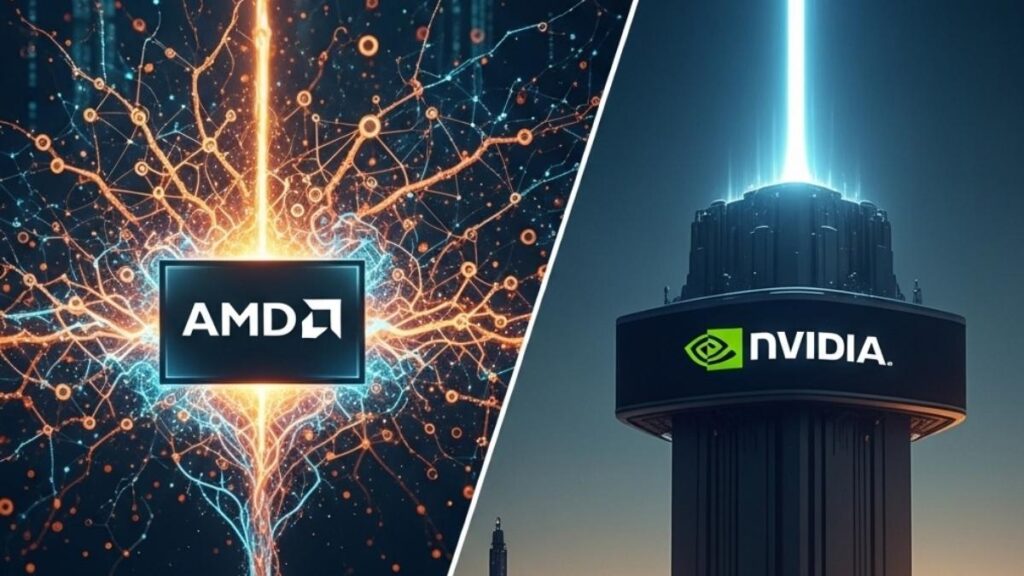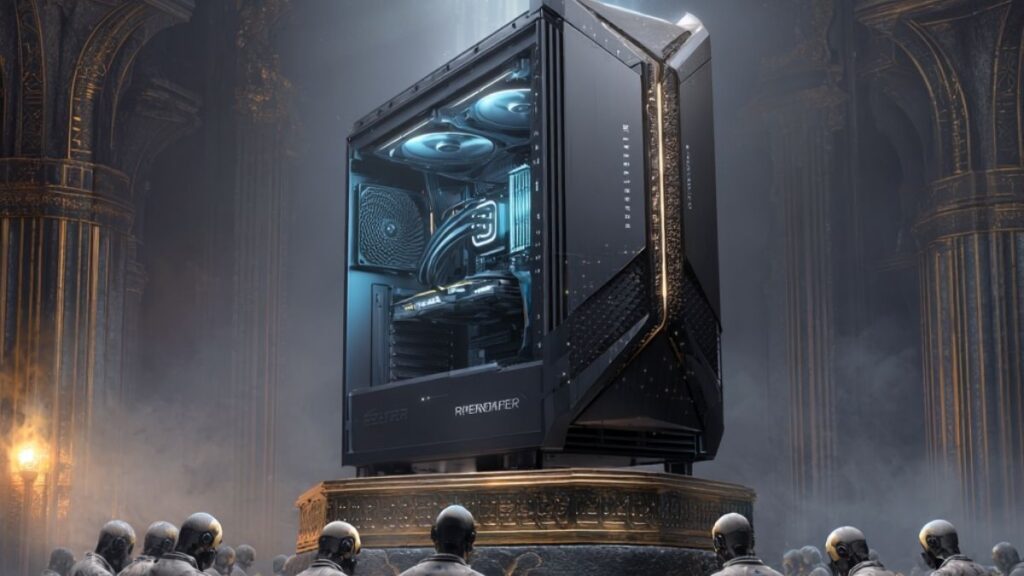For years, the AI hardware landscape has felt like a walled garden, with NVIDIA’s CUDA ecosystem and H100 GPUs reigning supreme, a bit like that one brilliant kid who never shares their toys. But here in Silicon Valley (I recently attended AMD’s Advancing AI event), where the spirit of open collaboration is as strong as our local craft beer, AMD is not just crashing the party; it’s bringing its own, much bigger, open-source playground. AMD’s recent advancements, particularly with the Instinct MI300 and MI350 series, demonstrate a strategic ascendancy driven by a relentless focus on open source and aggressive partnering, raising a critical question: is NVIDIA’s proprietary grip on AI about to loosen, potentially relegating it from leader to “has-been” if it doesn’t pivot, and pivot fast?
The Open-Source Engine: ROCm’s Unstoppable Momentum
The fundamental differentiator in AMD’s recent surge is its unwavering commitment to open source, primarily through its ROCm™ software stack. This isn’t just a philosophy; it’s a performance engine. While NVIDIA’s CUDA, for all its power, remains largely proprietary (requiring specific code rewrites for each new GPU generation, like trying to fit an H100 kernel onto a Blackwell chip – it just doesn’t work), ROCm offers unparalleled flexibility. AMD boasts rapidly advancing software capabilities, releasing updates every two weeks, ensuring day-zero support for leading AI models and algorithms. This relentless, developer-focused progress, combined with deepening ecosystem collaboration, results in out-of-the-box compatibility and accelerated innovation.
ROCm 7, set for preview on August 12th, promises a new era of performance, with improvements like 3.5x performance and 3x training speed on the same hardware compared to ROCm 6. It will support distributed inference and offer an Enterprise AI solution. Developers are actively engaged through hackathons, workshops, and contests (judged by an AI bot, naturally), further fueling ROCm’s rapid evolution. This open approach allows AMD to move far faster than NVIDIA’s closed model, as open source advances much more quickly due to massive collaboration than closed source. The numbers speak volumes: ROCm 7 is running 30% faster than NVIDIA’s CUDA in key workloads, and AMD’s chips deliver 40% more tokens per dollar on popular DeepSeek and Llama inference tasks.
Aggressive Partnering and Broad Availability: A Network Effect
AMD isn’t just building great chips; it’s building a formidable ecosystem. AMD’s customer-centric focus and willingness to create custom silicon have garnered appreciation. The Instinct MI325X, delivering on AMD’s annual hardware cadence, already boasts broad availability. Crucially, 7 of the 10 largest AI companies are now utilizing AMD Instinct, and Instinct is available from every major computer company, including IBM. This wide adoption isn’t accidental; it’s a direct result of AMD’s aggressive partnering strategy, which includes 24 initial server partners with a list set to expand significantly.
This collaborative approach extends to critical initiatives like sovereign AI efforts across over 40 different programs, fostering trust and widespread deployment that a single, proprietary vendor might struggle to achieve.
Leadership Hardware: Outperforming the Competition
AMD’s hardware is not just competitive; it’s leading. The Instinct MI355X is projected to significantly outperform NVIDIA’s B200 and GB200, delivering up to 4.2x performance on inference workloads generation-over-generation. They match or outperform NVIDIA by 30% in pre-training workloads using NVIDIA’s latest numbers and deliver up to 3.5x the performance over prior hardware for training. This relentless annual cadence of new hardware (MI350 shipping now, MI400 “Vulkan” due in 2026, and MI500 slated for 2027) ensures continuous generational leaps.
The AMD Helios AI rack reference platform, launching in 2026, utilizes 5th Gen EPYC processors, Instinct GPUs, Pensando DPUs, and ROCm, promising 50% more memory capacity, bandwidth, and scale-out bandwidth—delivering huge economic benefits for customers. This double-wide, predominantly water-cooled design, further boosted by Lenovo’s expertise in liquid cooling, highlights AMD’s holistic approach to high-performance AI infrastructure. The coming MI400 series is designed to deliver leadership performance, supporting up to 300 GB of scale-out bandwidth and delivering up to 10x more performance over MI355.
Trust and Stability: The IBM Advantage
In the high-stakes world of AI, trust isn’t just a buzzword; it’s a competitive advantage. AMD’s leadership stability, coupled with executives who often carry significant IBM backgrounds, translates into a far more trusted and enterprise-ready approach to AI compared to NVIDIA. This experience fosters a methodical, long-term vision and a deep understanding of customer needs beyond just raw silicon.
Networking the AI Future: Ultra-Ethernet and Pollara
Scaling AI models, which grow exponentially, demands sophisticated networking. AMD’s answer is the open-source Ultra-Ethernet effort and the Ultra-Accelerator Link. Its Pensando Pollara 400 AI NIC, now in full release, boasts a 20% performance advantage over the competition, 20X the performance of InfiniBand, and a 16% fabric cost advantage. This programmable NIC allows customers to build custom networking protocols, significantly improving throughput by avoiding bottlenecks. Oracle, for instance, is seeing up to a 5x performance increase in its AI deployments using MI355 GPUs with Pollara, and Juniper Networks is leveraging Pollara NICs to network massive numbers of both AMD and NVIDIA GPUs, massively outperforming InfiniBand. This is where NVIDIA’s lack of “Open” support is genuinely crippling its growth and performance, as the Vulkan AI NIC, shipping in 2026, promises up to 8x more scale-out bandwidth, massively exceeding NVIDIA performance.
Wrapping Up: NVIDIA’s Crossroads
AMD’s relentless pursuit of open-source excellence, coupled with its aggressive partnering, strong executive stability, and a continuous stream of leadership hardware, is propelling it to the forefront of the AI race. The performance numbers are undeniable: AMD is consistently outperforming NVIDIA in critical AI workloads, offering superior value and unmatched flexibility. This stark contrast between AMD’s open, collaborative ecosystem and NVIDIA’s proprietary, tightly controlled approach is creating a critical inflection point. If NVIDIA doesn’t correct its course very quickly, shedding its closed-source mentality and embracing a more open, customer-centric strategy, it risks watching its leadership position erode, potentially falling from market leader to “has-been” in the rapidly accelerating world of AI. The gauntlet has been thrown, and it’s open season for innovation.
- Lenovo’s AI Edge: How ‘Eating your Own Dog Food’ Creates a Competitive Advantage - August 8, 2025
- Threadripper PRO 9000: The Professional’s Unfair Advantage - August 7, 2025
- Energy as the Engine: Driving Economic Policy in Emerging Nations - July 25, 2025



